What Kind Of Things Are You Looking Forward To As NASA Gets Closer To The Artemis And Gateway Missions?
What kind of things are you looking forward to as NASA gets closer to the Artemis and Gateway missions? Do you plan to be a part of them?
More Posts from Nasa and Others
Build a Rover, Race a Rover!

Have you ever wanted to drive a rover across the surface of the Moon?
This weekend, students from around the world will get their chance to live out the experience on Earth! At the Human Exploration Rover Challenge, managed by NASA's Marshall Space Flight Center in Huntsville, Alabama, high schoolers and college students operate human-powered rovers that they designed and built as they traverse a simulated world, making decisions and facing obstacles that replicate what the next generation of explorers will face in space.

Though the teams that build the rover can be a few people or a few dozen, in the end, two students (one male, one female) will end up navigating their rover through a custom-built course at the U.S. Space and Rocket Center. Each duo will push their rover to the limit, climbing up hills, bumping over rocky and gravelly grounds, and completing mission objectives (like retrieving soil samples and planting their team flag) for extra points -- all in less than seven minutes.

2019 will mark the 25th year of Rover Challenge, which started life as the Great Moonbuggy Race on July 16, 1994. Six teams braved the rain and terrain (without a time limit) in the Rocket City that first year -- and in the end, the University of New Hampshire emerged victorious, powering through the moon craters, boulder fields and other obstacles in eighteen minutes and fifty-five seconds.

When it came time to present that year's design awards, though, the honors went to the University of Puerto Rico at Humacao, who have since become the only school to compete in every Great Moonbuggy Race and Rover Challenge hosted by NASA Marshall. The second-place finishers in 1994, the hometown University of Alabama in Huntsville, are the only other school to compete in both the first race and the 25th anniversary race in 2019.

Since that first expedition, the competition has only grown: the race was officially renamed the Human Exploration Rover Challenge for 2014, requiring teams to build even more of their rover from the wheels up, and last year, new challenges and tasks were added to better reflect the experience of completing a NASA mission on another planet. This year, almost 100 teams will be competing in Rover Challenge, hailing from 24 states, Washington, D.C., Puerto Rico, and countries from Bolivia to Bangladesh.

Rover Challenge honors the legacy of the NASA Lunar Roving Vehicle, which made its first excursion on the moon in 1971, driven by astronauts David Scott and James Irwin on Apollo 15. Given the competition's space race inspiration, it's only appropriate that the 25th year of Rover Challenge is happening in 2019, the 50th anniversary of Neil Armstrong and Buzz Aldrin's historic Apollo 11 moon landing.

Interested in learning more about Rover Challenge? Get the details on the NASA Rover Challenge site -- then join us at the U.S. Space and Rocket Center (entrance is free) or watch live on the Rover Challenge Facebook Page starting at 7 AM CT, this Friday, April 12 and Saturday, April 13. Happy roving!
Make sure to follow us on Tumblr for your regular dose of space: http://nasa.tumblr.com
From Microscopic to Multicellular: Six Stories of Life that We See from Space
Life. It's the one thing that, so far, makes Earth unique among the thousands of other planets we've discovered. Since the fall of 1997, NASA satellites have continuously and globally observed all plant life at the surface of the land and ocean. During the week of Nov. 13-17, we are sharing stories and videos about how this view of life from space is furthering knowledge of our home planet and the search for life on other worlds.

Earth is the only planet with life, as far as we know. From bacteria in the crevices of the deepest oceans to monkeys swinging between trees, Earth hosts life in all different sizes, shapes and colors. Scientists often study Earth from the ground, but some also look to our satellites to understand how life waxes and wanes on our planet.
Over the years, scientists have used this aerial view to study changes in animal habitats, track disease outbreaks, monitor forests and even help discover a new species. While this list is far from comprehensive, these visual stories of bacteria, plants, land animals, sea creatures and birds show what a view from space can reveal.
1. Monitoring the single-celled powerhouses of the sea

Known as the grass of the ocean, phytoplankton are one of the most abundant types of life in the ocean. Usually single-celled, these plant-like organisms are the base of the marine food chain. They are also responsible for the only long-term transfer of carbon dioxide from Earth’s atmosphere to the ocean.
Even small changes in phytoplankton populations can affect carbon dioxide concentrations in the atmosphere, which could ultimately affect Earth’s global surface temperatures. Scientists have been observing global phytoplankton populations continuously since 1997 starting with the Sea-Viewing Wide Field-of View Sensor (SeaWiFS). They continue to study the small life-forms by satellite, ships and aircrafts.
2. Predicting cholera bacteria outbreaks
Found on the surface of zooplankton and in contaminated water, the bacteria that cause the infectious disease cholera — Vibrio cholerae — affect millions of people every year with severe diarrhea, sometimes leading to death. While our satellite sensors can’t detect the actual bacteria, scientists use various satellite data to look for the environmental conditions that the bacteria thrive in.
Specifically, microbiologist Rita Colwell at the University of Maryland, College Park, and West Virginia University hydrologist Antar Jutla studied data showing air and ocean temperature, salinity, precipitation, and chlorophyllconcentrations, the latter a marker for zooplankton. Anticipating where the bacteria will bloom helps researchers to mitigate outbreaks.

Recently, Colwell and Jutla have been able to estimate cholera risk after major events, such as severe storms, by looking at satellite precipitation data, air temperature, and population maps. The two maps above show the team's predicted cholera risk in Haiti two weeks after Hurricane Matthew hit over October 1-2, 2016 and the actual reported cholera cases in October 2016.
3. Viewing life on land
From helping preserve forests for chimpanzees to predicting deer population patterns, scientists use our satellites to study wildlife across the world. Satellites can also see the impacts of perhaps the most relatable animal to us: humans. Every day, we impact our planet in many ways including driving cars, constructing buildings and farming – all of which we can see with satellites.

Our Black Marble image provides a unique view of human activity. Looking at trends in our lights at night, scientists can study how cities develop over time, how lighting and activity changes during certain seasons and holidays, and even aid emergency responders during power outages caused by natural disasters.
4. Tracking bird populations
Scientists use our satellite data to study birds in a variety of ways, from understanding their migratory patterns, to spotting potential nests, to tracking populations. In a rather creative application, scientists used satellite imagery to track Antarctica’s emperor penguin populations by looking for their guano – or excrement.

Counting emperor penguins from the ground perspective is challenging because they breed in some of the most remote and cold places in the world, and in colonies too large to easily count manually. With their black and white coats, emperor penguins are also difficult to count from an aerial view as they sometimes blend in with shadows on the ice. Instead, Phil Trathan and his colleagues at the British Antarctic Survey looked through Landsat imagery for brown stains on the sea ice. By looking for penguin droppings, Trathan said his team identified 54 emperor penguin colonies along the Antarctic coast.
5. Parsing out plant life
Just as we see plants grow and wilt on the ground, satellites observe the changes from space. Flourishing vegetation can indicate a lively ecosystem while changes in greenery can sometimes reveal natural disasters, droughts or even agricultural practices. While satellites can observe plant life in our backyards, scientists can also use them to provide a global picture.

Using data from satellites including SeaWiFS, and instruments including the NASA/NOAA Visible Infrared Imaging Radiometer Suite and the Moderate Resolution Imaging Spectroradiometer, scientists have the most complete view of global biology to date, covering all of the plant life on land and at the surface of the ocean.
6. Studying life under the sea
Our satellites have helped scientists study creatures living in the oceans whether it’s finding suitable waters for oysters or protecting the endangered blue whale. Scientists also use the data to learn more about one of the most vulnerable ecosystems on the planet – coral reefs.

They may look like rocks or plants on the seafloor, but corals are very much living animals. Receiving sustenance from photosynthetic plankton living within their calcium carbonate structures, coral reefs provide food and shelter for many kinds of marine life, protect shorelines from storms and waves, serve as a source for potential medicines, and operate as some of the most diverse ecosystems on the planet.

However, coral reefs are vulnerable to the warming of the ocean and human activity. Our satellites measure the surface temperature of ocean waters. These measurements have revealed rising water temperatures surrounding coral reef systems around the world, which causes a phenomenon known as “coral bleaching.” To add to the satellite data, scientists use measurements gathered by scuba divers as well as instruments flown on planes.
During the week of Nov. 13-17, check out our stories and videos about how this view of life from space is furthering knowledge of our home planet and the search for life on other worlds. Follow at www.nasa.gov/Earth.
Make sure to follow us on Tumblr for your regular dose of space: http://nasa.tumblr.com.
Solar System: Things to Know This Week
Celebrate with us as our Opportunity rover turns 13, view art from our fans and more!
1. All Grown Up
After exceeding her 90-day mission and design parameters many times over, our plucky little rover Opportunity turns 13 years old on the Red Planet. She’s officially a teenager!
2. People’s Space

The public contributes so much wonderful art that we decided to make a place to share it. Enjoy!
3. Ready for a Close Up

Our Juno spacecraft recently got a closer look at Jupiter’s Little Red Spot. The craft’s JunoCam imager snapped this shot of Jupiter's northern latitudes on December 2016, as the spacecraft performed a close flyby of the gas giant. The spacecraft was at an altitude of 10,300 miles above Jupiter's cloud tops.
4. A New Test for Life on Other Planets

A simple chemistry method could vastly enhance how scientists search for signs of life on other planets. The test uses a liquid-based technique known as capillary electrophoresis to separate a mixture of organic molecules into its components. It was designed specifically to analyze for amino acids, the structural building blocks of all life on Earth.
5. Blurring the Line Between Asteroid and Comet

Our NEOWISE mission recently discovered some celestial objects traveling through our neighborhood, including one on the blurry line between asteroid and comet. An object called 2016 WF9 was detected by the NEOWISE project in November 2016 and it's in an orbit that takes it on a scenic tour of our solar system. A different object, discovered by NEOWISE a month earlier, is more clearly a comet, releasing dust as it nears the sun.
Discover the full list of 10 things to know about our solar system this week HERE.
Make sure to follow us on Tumblr for your regular dose of space: http://nasa.tumblr.com
Dark Matter 101: Looking for the missing mass
Here’s the deal — here at NASA we share all kinds of amazing images of planets, stars, galaxies, astronauts, other humans, and such, but those photos can only capture part of what’s out there. Every image only shows ordinary matter (scientists sometimes call it baryonic matter), which is stuff made from protons, neutrons and electrons. The problem astronomers have is that most of the matter in the universe is not ordinary matter – it’s a mysterious substance called dark matter.

What is dark matter? We don’t really know. That’s not to say we don’t know anything about it – we can see its effects on ordinary matter. We’ve been getting clues about what it is and what it is not for decades. However, it’s hard to pinpoint its exact nature when it doesn’t emit light our telescopes can see.
Misbehaving galaxies
The first hint that we might be missing something came in the 1930s when astronomers noticed that the visible matter in some clusters of galaxies wasn’t enough to hold the cluster together. The galaxies were moving so fast that they should have gone zinging out of the cluster before too long (astronomically speaking), leaving no cluster behind.

Simulation credit: ESO/L. Calçada
It turns out, there’s a similar problem with individual galaxies. In the 1960s and 70s, astronomers mapped out how fast the stars in a galaxy were moving relative to its center. The outer parts of every single spiral galaxy the scientists looked at were traveling so fast that they should have been flying apart.

Something was missing – a lot of it! In order to explain how galaxies moved in clusters and stars moved in individual galaxies, they needed more matter than scientists could see. And not just a little more matter. A lot . . . a lot, a lot. Astronomers call this missing mass “dark matter” — “dark” because we don’t know what it is. There would need to be five times as much dark matter as ordinary matter to solve the problem.
Holding things together
Dark matter keeps galaxies and galaxy clusters from coming apart at the seams, which means dark matter experiences gravity the same way we do.

In addition to holding things together, it distorts space like any other mass. Sometimes we see distant galaxies whose light has been bent around massive objects on its way to us. This makes the galaxies appear stretched out or contorted. These distortions provide another measurement of dark matter.
Undiscovered particles?
There have been a number of theories over the past several decades about what dark matter could be; for example, could dark matter be black holes and neutron stars – dead stars that aren’t shining anymore? However, most of the theories have been disproven. Currently, a leading class of candidates involves an as-yet-undiscovered type of elementary particle called WIMPs, or Weakly Interacting Massive Particles.

Theorists have envisioned a range of WIMP types and what happens when they collide with each other. Two possibilities are that the WIMPS could mutually annihilate, or they could produce an intermediate, quickly decaying particle. In both cases, the collision would end with the production of gamma rays — the most energetic form of light — within the detection range of our Fermi Gamma-ray Space Telescope.
Tantalizing evidence close to home
A few years ago, researchers took a look at Fermi data from near the center of our galaxy and subtracted out the gamma rays produced by known sources. There was a left-over gamma-ray signal, which could be consistent with some forms of dark matter.

While it was an exciting finding, the case is not yet closed because lots of things at the center of the galaxy make gamma rays. It’s going to take multiple sightings using other experiments and looking at other astronomical objects to know for sure if this excess is from dark matter.

In the meantime, Fermi will continue the search, as it has over its 10 years in space. Learn more about Fermi and how we’ve been celebrating its first decade in space.
Make sure to follow us on Tumblr for your regular dose of space: http://nasa.tumblr.com.

Home is Where the Astronaut Is…
The International Space Station serves as a home, office and recreation room for astronauts. They share this confined space far above the Earth with crew members from different countries and cultures for as long as six months or more. At the same time, maintaining individual well-being and crew harmony is important for the crew and mission success.
The Culture, Values and Environmental Adaptation in Space (At Home in Space) Investigation, looks at changes in perceptions about home in space and the ways a unique culture may develop aboard the station during a mission. Discover more about this study HERE.
Make sure to follow us on Tumblr for your regular dose of space: http://nasa.tumblr.com
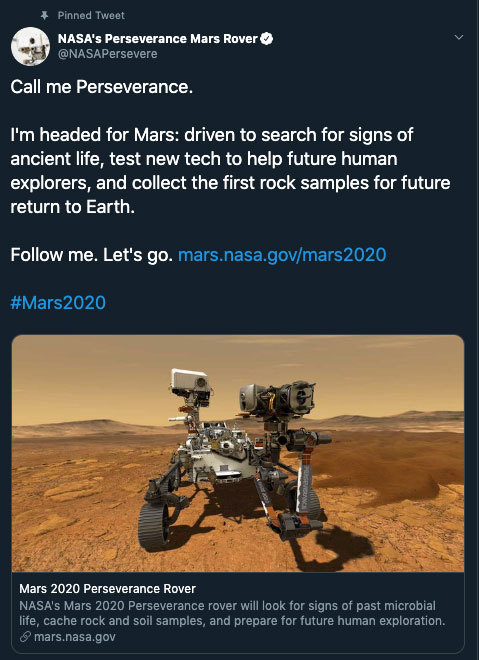
Allow us to reintroduce someone ... the name’s Perseverance.
With this new name, our Mars 2020 rover has now come to life! Chosen by middle school student Alex Mather, Perseverance helps to remind ourselves that no matter what obstacles we face, whether it's on the way to reaching our goals or on the way to Mars, we will push through. In Alex’s own words,
“We are a species of explorers, and we will meet many setbacks on the way to Mars. However, we can persevere. We, not as a nation but as humans, will not give up. The human race will always persevere into the future.”
Welcome to the family. ❤️
Make sure to follow us on Tumblr for your regular dose of space: http://nasa.tumblr.com.
You Are Made of Stardust
Though the billions of people on Earth may come from different areas, we share a common heritage: we are all made of stardust! From the carbon in our DNA to the calcium in our bones, nearly all of the elements in our bodies were forged in the fiery hearts and death throes of stars.
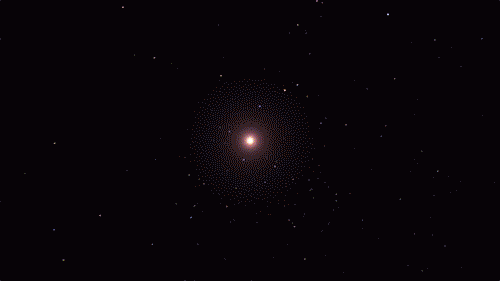
The building blocks for humans, and even our planet, wouldn’t exist if it weren’t for stars. If we could rewind the universe back almost to the very beginning, we would just see a sea of hydrogen, helium, and a tiny bit of lithium.
The first generation of stars formed from this material. There’s so much heat and pressure in a star’s core that they can fuse atoms together, forming new elements. Our DNA is made up of carbon, hydrogen, oxygen, nitrogen, and phosphorus. All those elements (except hydrogen, which has existed since shortly after the big bang) are made by stars and released into the cosmos when the stars die.

Each star comes with a limited fuel supply. When a medium-mass star runs out of fuel, it will swell up and shrug off its outer layers. Only a small, hot core called a white dwarf is left behind. The star’s cast-off debris includes elements like carbon and nitrogen. It expands out into the cosmos, possibly destined to be recycled into later generations of stars and planets. New life may be born from the ashes of stars.
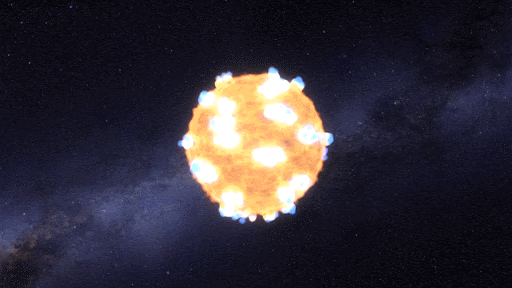
Massive stars are doomed to a more violent fate. For most of their lives, stars are balanced between the outward pressure created by nuclear fusion and the inward pull of gravity. When a massive star runs out of fuel and its nuclear processes die down, it completely throws the star out of balance. The result? An explosion!
Supernova explosions create such intense conditions that even more elements can form. The oxygen we breathe and essential minerals like magnesium and potassium are flung into space by these supernovas.
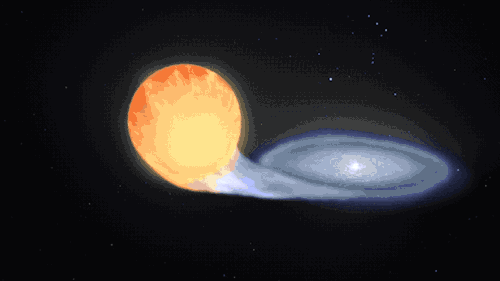
Supernovas can also occur another way in binary, or double-star, systems. When a white dwarf steals material from its companion, it can throw everything off balance too and lead to another kind of cataclysmic supernova. Our Nancy Grace Roman Space Telescope will study these stellar explosions to figure out what’s speeding up the universe’s expansion.
This kind of explosion creates calcium – the mineral we need most in our bodies – and trace minerals that we only need a little of, like zinc and manganese. It also produces iron, which is found in our blood and also makes up the bulk of our planet’s mass!

A supernova will either leave behind a black hole or a neutron star – the superdense core of an exploded star. When two neutron stars collide, it showers the cosmos in elements like silver, gold, iodine, uranium, and plutonium.

Some elements only come from stars indirectly. Cosmic rays are nuclei (the central parts of atoms) that have been boosted to high speed by the most energetic events in the universe. When they collide with atoms, the impact can break them apart, forming simpler elements. That’s how we get boron and beryllium – from breaking star-made atoms into smaller ones.
Half a dozen other elements are created by radioactive decay. Some elements are radioactive, which means their nuclei are unstable. They naturally break down to form simpler elements by emitting radiation and particles. That’s how we get elements like radium. The rest are made by humans in labs by slamming atoms of lighter elements together at super high speeds to form heavier ones. We can fuse together elements made by stars to create exotic, short-lived elements like seaborgium and einsteinium.
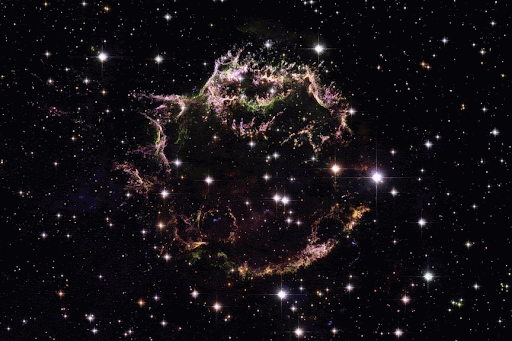
From some of the most cataclysmic events in the cosmos comes all of the beauty we see here on Earth. Life, and even our planet, wouldn’t have formed without them! But we still have lots of questions about these stellar factories.
In 2006, our Stardust spacecraft returned to Earth containing tiny particles of interstellar dust that originated in distant stars, light-years away – the first star dust to ever be collected from space and returned for study. You can help us identify and study the composition of these tiny, elusive particles through our Stardust@Home Citizen Science project.
Our upcoming Roman Space Telescope will help us learn more about how elements were created and distributed throughout galaxies, all while exploring many other cosmic questions. Learn more about the exciting science this mission will investigate on Twitter and Facebook.
Make sure to follow us on Tumblr for your regular dose of space!
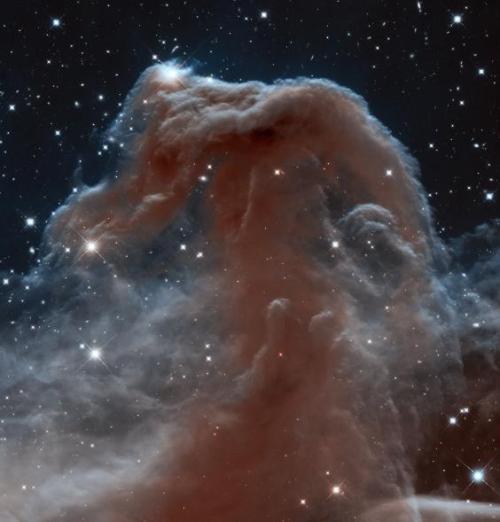
Known as the Horsehead Nebula – but you can call it Starbiscuit.
Found by our Hubble Space Telescope, this beauty is part of a much larger complex in the constellation Orion.
Make sure to follow us on Tumblr for your regular dose of space: http://nasa.tumblr.com.
Take a deep breath. Even if the air looks clear, it is nearly certain that you will inhale millions of solid particles and liquid droplets. These ubiquitous specks of matter are known as aerosols, and they can be found in the air over oceans, deserts, mountains, forests, ice, and every ecosystem in between.
If you have ever watched smoke billowing from a wildfire, ash erupting from a volcano, or dust blowing in the wind, you have seen aerosols. Satellites like Terra, Aqua, Aura, and Suomi NPP “see” them as well, though they offer a completely different perspective from hundreds of kilometers above Earth’s surface. A version of one of our models called the Goddard Earth Observing System Forward Processing (GEOS FP) offers a similarly expansive view of the mishmash of particles that dance and swirl through the atmosphere.
The visualization above highlights GEOS FP model output for aerosols on August 23, 2018. On that day, huge plumes of smoke drifted over North America and Africa, three different tropical cyclones churned in the Pacific Ocean, and large clouds of dust blew over deserts in Africa and Asia. The storms are visible within giant swirls of sea salt aerosol(blue), which winds loft into the air as part of sea spray. Black carbon particles (red) are among the particles emitted by fires; vehicle and factory emissions are another common source. Particles the model classified as dust are shown in purple. The visualization includes a layer of night light data collected by the day-night band of the Visible Infrared Imaging Radiometer Suite (VIIRS) on Suomi NPP that shows the locations of towns and cities.
Make sure to follow us on Tumblr for your regular dose of space: http://nasa.tumblr.com.
5 Times Astronaut Jack Fischer Said Something in Space Was “Awesome”
Meet astronaut Jack Fischer…

He was selected as a NASA astronaut in July 2009, and is currently living and working in space for his first time. As you can imagine, going to space for the first time is both nerve-wracking and exciting. You may or may not know just how excited he actually is to be 250 miles above the Earth...To communicate his elation, he has frequently used some version of the word “awesome”.
FYI, that’s a picture of Fischer about to eat a coffee ball on station. For more on his opinion of coffee balls, check THIS out.
Let’s take a look at a few times astronaut Jack Fischer said something in space was “awesome”…
1. Burrito Smothered in Awesomesauce
Immediately following the hatch opening to the International Space Station and Jack Fischer arriving at his new orbital home, they had the chance to speak to their families. During this time, he explained to his wife what it was like to be in space...obviously using the word awesome in the process: “It’s a burrito of awesomeness, smothered in awesomesauce baby, it’s so beautiful!”
2. Awesome Views from Space

Astronauts commonly say that one of the best parts of being on space station is the view. Earth from 250 miles above can look stunning...or as Fischer puts it...awesome!
3. Tornado of Awesomeness
Fischer shared this video on his Twitter account on May 6 saying, “Sometimes, on a weekend, you have to spin about wildly…we can call it a tornado of awesomeness—because weightlessness is awesome!”
4. Awesome #SpaceSelfie

This selfie, taken during Fischer’s first-ever spacewalk is AWESOME and shows his cheesing smile from behind his spacesuit helmet. Check out a recap of Fischer’s first spacewalk, conducted on May 12, HERE.
5. Fondue Pot Bubbling Over with Awesome Sauce
In this video, also taken during Fischer’s first spacewalk on May 12, you can hear his real-time reaction to seeing the Earth from outside the space station. Describing it like a “Ginormous fondue pot, bubbling over with piping hot awesomesauce.”
Why the Burrito References?

You might be wondering where all this burrito talk comes from. In a pre-flight interview, Fischer explained that he doesn’t particularly like sweets...so for his birthday, his wife will commonly make him bean burritos smothered in green chili and cheese! Watch the full video for 5 facts you may not know about Fischer HERE.
Want more awesomeness from Jack Fischer? Follow him on social media for regular, awesome updates!
Twitter | Facebook | Instagram
Make sure to follow us on Tumblr for your regular dose of space: http://nasa.tumblr.com
-
 watch reblogged this · 1 year ago
watch reblogged this · 1 year ago -
 disastrousfeline liked this · 5 years ago
disastrousfeline liked this · 5 years ago -
 just-peachy-posts reblogged this · 5 years ago
just-peachy-posts reblogged this · 5 years ago -
 just-peachy-posts liked this · 5 years ago
just-peachy-posts liked this · 5 years ago -
 iveagixxer liked this · 5 years ago
iveagixxer liked this · 5 years ago -
 not-the-fortunate-ones-fan liked this · 5 years ago
not-the-fortunate-ones-fan liked this · 5 years ago -
 j-c-laredo liked this · 5 years ago
j-c-laredo liked this · 5 years ago -
 vioecho reblogged this · 5 years ago
vioecho reblogged this · 5 years ago -
 vioecho liked this · 5 years ago
vioecho liked this · 5 years ago -
 shailendra65631 reblogged this · 5 years ago
shailendra65631 reblogged this · 5 years ago -
 shailendra65631 liked this · 5 years ago
shailendra65631 liked this · 5 years ago -
 cherryobvious liked this · 5 years ago
cherryobvious liked this · 5 years ago -
 a-veteran-for-veterans-things liked this · 5 years ago
a-veteran-for-veterans-things liked this · 5 years ago -
 camwarva liked this · 5 years ago
camwarva liked this · 5 years ago -
 adt-space reblogged this · 5 years ago
adt-space reblogged this · 5 years ago -
 m3adowprincess liked this · 5 years ago
m3adowprincess liked this · 5 years ago -
 smol-bean-dragon-hoard liked this · 5 years ago
smol-bean-dragon-hoard liked this · 5 years ago -
 fredericverdie-blog liked this · 5 years ago
fredericverdie-blog liked this · 5 years ago -
 spaciegracie07 liked this · 5 years ago
spaciegracie07 liked this · 5 years ago -
 qsxam liked this · 5 years ago
qsxam liked this · 5 years ago -
 totally-not-bellatrix liked this · 5 years ago
totally-not-bellatrix liked this · 5 years ago -
 johancone liked this · 5 years ago
johancone liked this · 5 years ago -
 whitecatnatalie liked this · 5 years ago
whitecatnatalie liked this · 5 years ago -
 melbuzz liked this · 5 years ago
melbuzz liked this · 5 years ago -
 handageddon liked this · 5 years ago
handageddon liked this · 5 years ago -
 aki-kalchek-blog liked this · 5 years ago
aki-kalchek-blog liked this · 5 years ago -
 the-breloominati reblogged this · 5 years ago
the-breloominati reblogged this · 5 years ago -
 the-breloominati liked this · 5 years ago
the-breloominati liked this · 5 years ago -
 warriorsofficial reblogged this · 5 years ago
warriorsofficial reblogged this · 5 years ago -
 wizzyspace reblogged this · 5 years ago
wizzyspace reblogged this · 5 years ago -
 greatstudenthoagielight-blog liked this · 5 years ago
greatstudenthoagielight-blog liked this · 5 years ago -
 readinginzerogravity liked this · 5 years ago
readinginzerogravity liked this · 5 years ago -
 weird-is-all-ive-got reblogged this · 5 years ago
weird-is-all-ive-got reblogged this · 5 years ago -
 stars-that-do-not-give-a-damn liked this · 5 years ago
stars-that-do-not-give-a-damn liked this · 5 years ago -
 man0fthemoon liked this · 5 years ago
man0fthemoon liked this · 5 years ago -
 thereflectingthicket liked this · 5 years ago
thereflectingthicket liked this · 5 years ago -
 delightfulpaperpost liked this · 5 years ago
delightfulpaperpost liked this · 5 years ago -
 theknightsystem liked this · 5 years ago
theknightsystem liked this · 5 years ago -
 oshinytomato liked this · 5 years ago
oshinytomato liked this · 5 years ago -
 combatentejonarque liked this · 5 years ago
combatentejonarque liked this · 5 years ago -
 books-coffe-rain-blog liked this · 5 years ago
books-coffe-rain-blog liked this · 5 years ago -
 nobeerreviews liked this · 5 years ago
nobeerreviews liked this · 5 years ago -
 joycedoliver liked this · 5 years ago
joycedoliver liked this · 5 years ago
Explore the universe and discover our home planet with the official NASA Tumblr account
1K posts